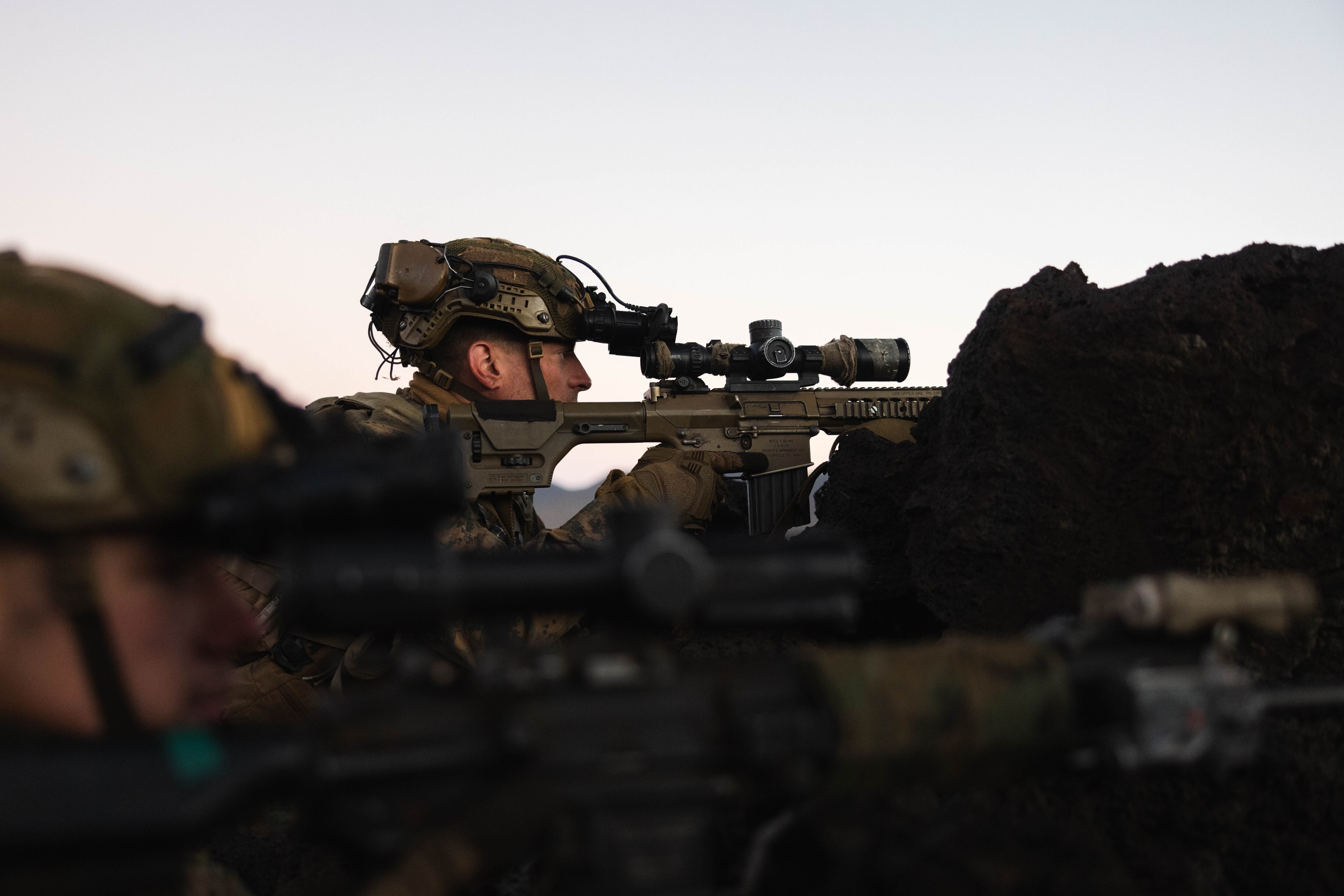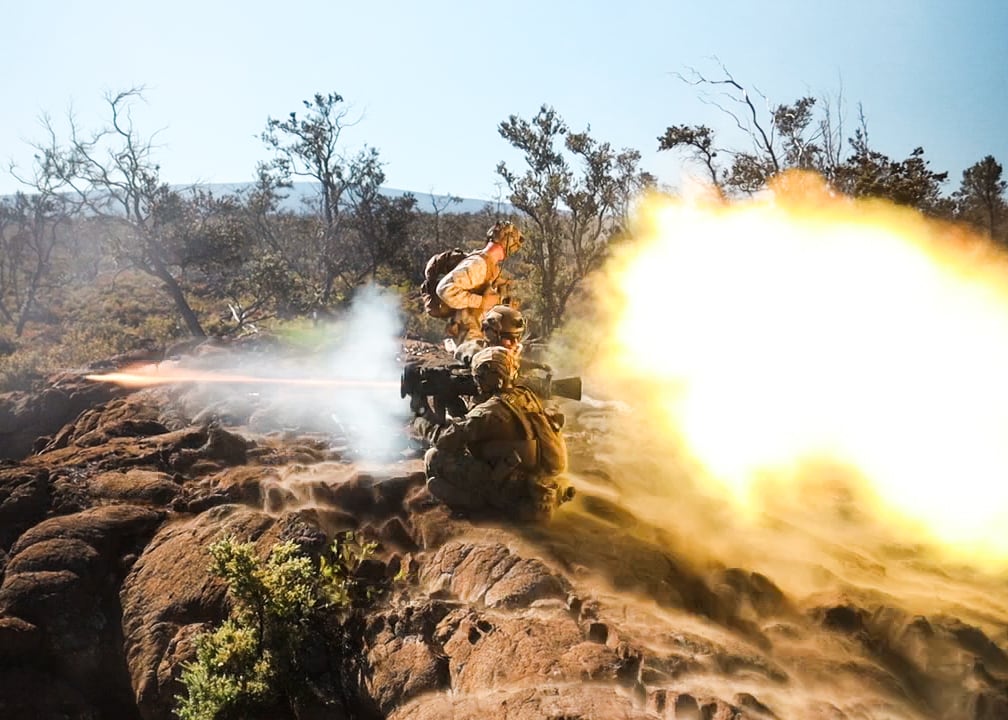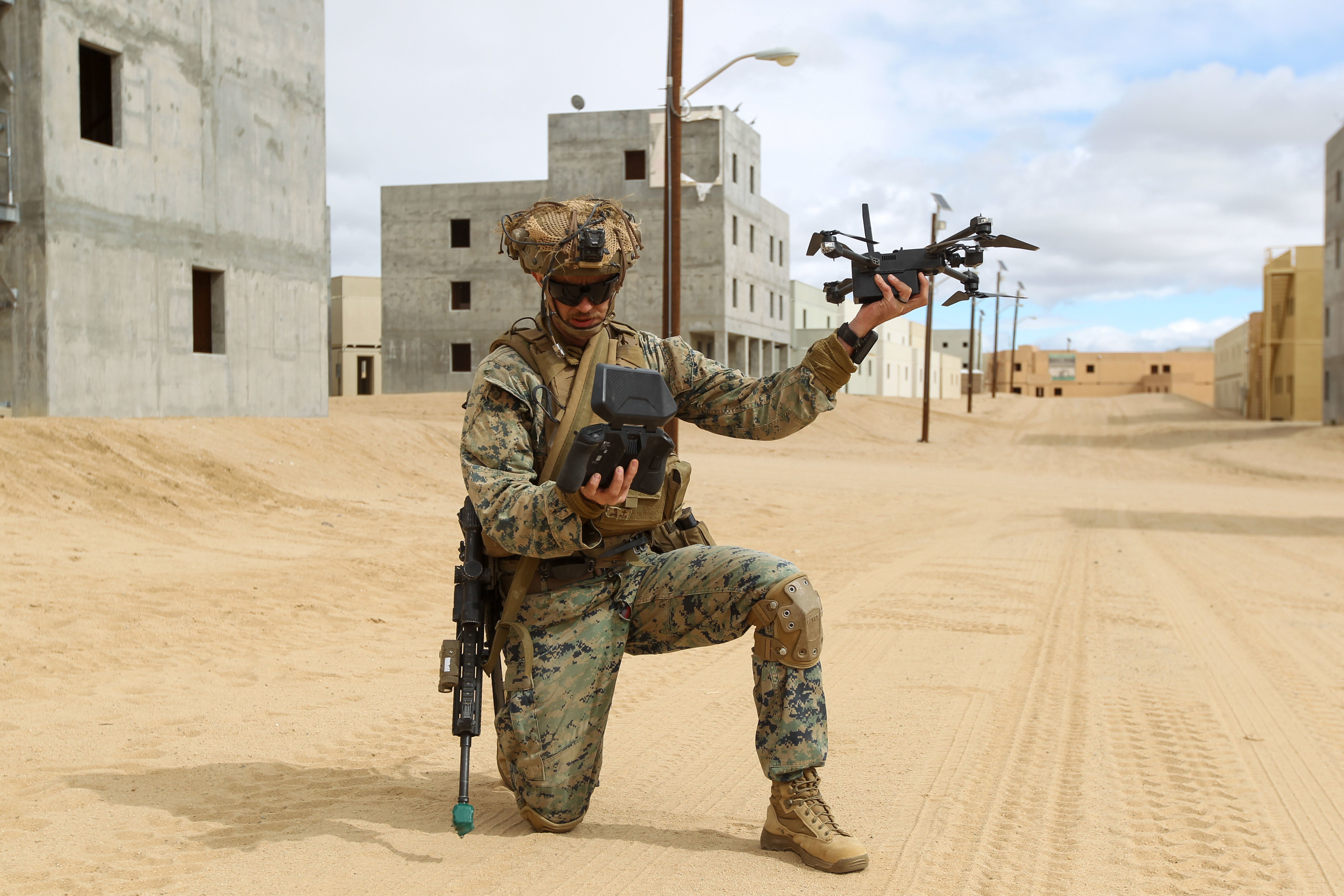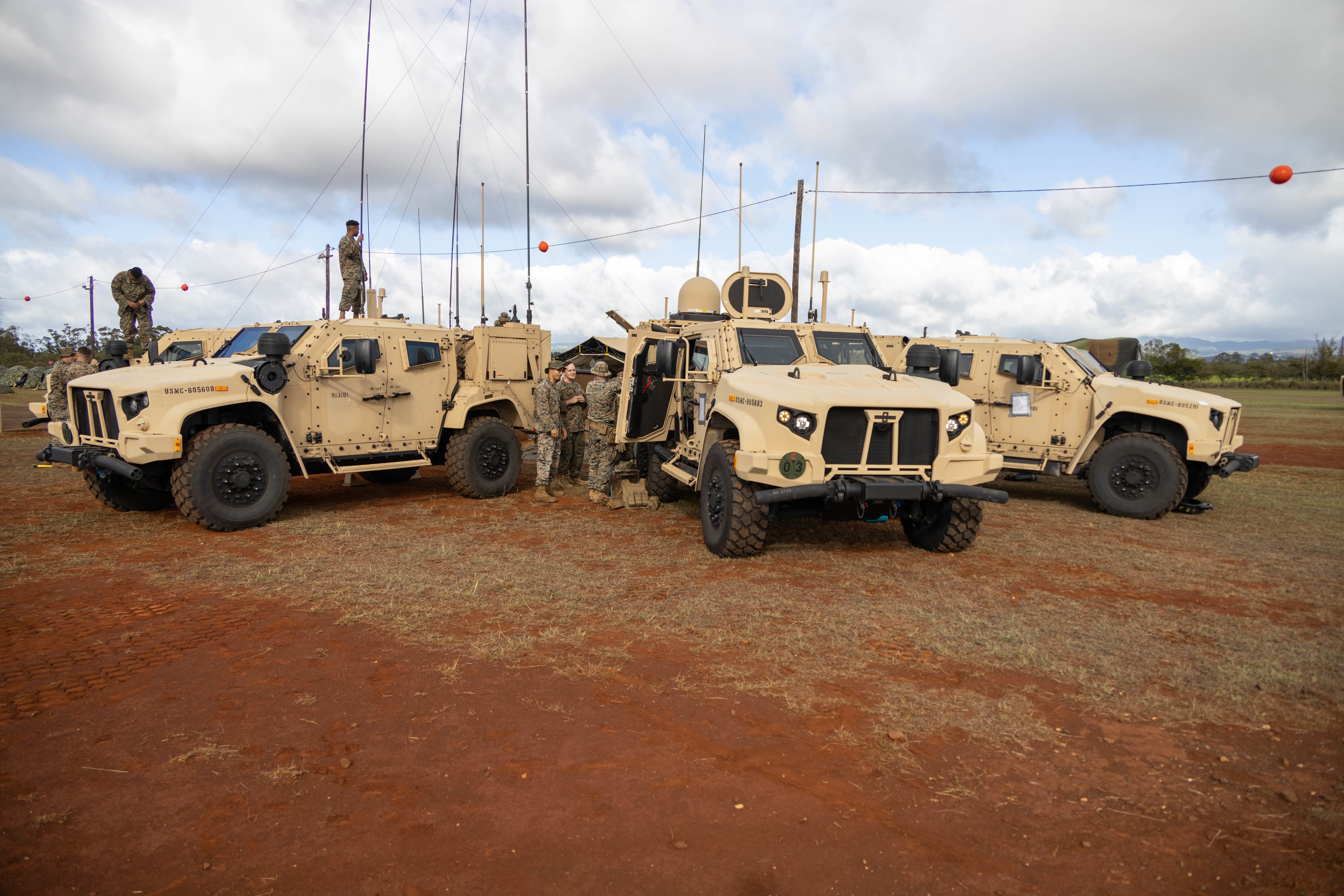It started in 2016, when then-Lt. Gen. David Berger looked at Marine units in the Pacific and saw that without radical changes, the Corps would be sidelined, or worse, in the most likely next fight.
As commander of Marine Forces Pacific, he’d seen wargames showing the Marine Corps battle its potentially biggest foe: China.
The service was set up to deliver two brigades’ worth of infantry and combined arms to a land fight that looked a lot more like the Korean War than what they would face in what experts envision as a 21st century, high-tech, long-range striking conflict.
Could the Corps keep up?
It was the start of the future commandant’s Force Design transformation plan — and the birth of the Marine littoral regiment.
To win against China, he’s said, Marine units would need to be trained and equipped to operate in variety of sized units. They’d need to be able venture across wide distances, with a focus on the littoral zone, where land and sea meet.
As the Marine Corps has worked through its transformation known as Force Design in recent years, officials have restructured the infantry battalion, shed legacy equipment such as tanks and reduced artillery.
RELATED

The Corps has added drones, anti-aircraft equipment and is developing a ship-sinking missile.
All of this is to position the service to do what its top leaders think will be the most pressing future challenge: support the Navy and the joint force countering China in the Pacific.
The Corps’ newest regiment, the Marine littoral regiment, combines new drone and sensing tech, anti-aircraft equipment and a ship-sinking missile into one formation — purpose-built to move around the land and sea, hopefully going unnoticed so that it can strike when needed, allowing Navy ships to roam freely while thwarting the Chinese military’s access to key terrain and maritime choke points.
Two regiments have stood up since the new formation concept was announced in 2020 — the 3rd Marine Littoral Regiment based in Hawaii, formerly the
3rd Marine Regiment infantry unit, and in late 2023 the 12th Marine Littoral Regiment based in Okinawa, Japan, formerly 12th Marine Regiment artillery unit.
A third, and final, Marine littoral regiment is planned to launch in 2027, based out of Guam and using a rotational force, rather than a permanently stationed unit for its manpower.
The regiments are about the size of a Marine expeditionary unit, with about 2,100 Marines and sailors — smaller than a standard infantry regiment, which contains 3,000 or more Marines.
Commandant Gen. Eric Smith has stressed that the Marine littoral regiment is still a version of the Marine air-ground task force, the construct used to build nearly all Marine formations from the Marine expeditionary unit to the Marine expeditionary brigade and Marine expeditionary force.
“It’s just sized and purpose-built for its task, which is to be light, lethal and austere and to be able to stand in the weapons engagement zone when others are going to have to leave because of the threat,” he told War on the Rocks in 2023.
“They are exactly what we need in the Pacific,” Smith said. “It is the best solution to the task we’ve been given.”
And that task is to enable the Navy to fight the naval fight.
What that’s meant for 3rd Marine Littoral Regiment and will mean for 12th Marine Littoral Regiment and the subsequent regiment in Guam as they build manpower and capabilities, is fewer Marines, new equipment, novel approaches to getting to and staying in the fight, and a shift in focus from infantry to sensing and targeting.
Key differences
Lt. Col. Brandon Ward heads the Marine littoral regiment integration efforts at combat development and integration.
Past infantry and artillery units before the force design changes were organized for when the focus was more on operating on the Korean peninsula or being able to deploy two brigades worth of Marines if needed for a large-scale conflict.
But with China’s air defense systems and growing naval fleet, a Marine unit now needs to task organize and create “windows of opportunity” in those anti-access areas so the Navy and joint services can bring in their weapons or forces, he said.
This required moving away from infantry-heavy formations, with shorter-range conventional artillery and to longer-range systems such as the Navy-Marine Corps expeditionary ship interdiction system, or NMESIS.
The Navy-Marine Corps expeditionary ship interdiction system combines a joint light tactical vehicle with remote controls and mounts a Naval strike missile on the frame, giving users a mobile missile system in a single package.

Members of 3rd Marine littoral regiment’s littoral combat team are doing new equipment training with the Navy-Marine Corps expeditionary ship interdiction system, with fielding expected in fiscal year 2025.
The regiment’s sensing capability is as important or more important than its missiles, said Col. John Lehane, 3rd Marine littoral regiment commander. Marine senior leaders have emphasized reconnaissance and counter-reconnaissance capabilities as a key Corps contribution.
“We’re giving to the (combatant) commander a low signature team with the ability to stand inside a weapons engagement zone and provide them information in a manner that is not risking an (Airborne Warning and Control System), a $1.6 billion destroyer or take your pick of high value asset that might be at risk when we can take that risk for you,” Lehane said.
To build a formation that could task organize from as small as a handful of Marines to an entire regiment, depending on the mission, required some structural overhauls.
A standard infantry regiment holds more than 3,000 Marines with a headquarters company, combat assault company and three infantry battalions, which include its own headquarters, weapons and rifle companies. The regiment is augmented by artillery and sometimes also task-organized for specific missions.
The Marine littoral regiment comprises three main elements — the littoral combat team, the littoral logistics battalion and the littoral anti-air battalion — all overseen by the regimental headquarters, which contains a headquarters and service company, communications company and a long-range unmanned surface vessel company. It has approximately 2,100 personnel.
Signaling the shift in needs, the headquarters communications company is three times the size of that of a standard infantry regiment with much more commercial communications technology, Lehane said.
This means Marines in the new littoral regiments will likely be senior in rank and be put in teams with Marines from other job fields more often. Smaller groups with mixes of infantry, communications, artillery and logistics running operations far from headquarters.
The regimental and battalion headquarters will push their experts in various areas down to those teams as they organize them for a individual missions.
The littoral combat team holds three infantry companies, a fire direction center section, engineer platoon and medium missile battery.
The littoral anti-air battalion focuses on the skies with an air control battery, sensor platoon ground based air defense and Marine air defense integrated system platoons to counter enemy surveillance, missile and drone strikes.
Having air domain awareness, air defense and advanced sensing wasn’t something the ground combat element of the Marine air-ground task force could do in the past, Lehane said.
The littoral logistics battalion has a variety of engineer, communications, supply, fuel and ordnance teams, platoons and sections.
Much like changes made in the recent infantry battalion experiments, which bumped ranks up by one to two echelons, such as making staff sergeant the standard rank for a squad leader, the regiment is doing the same.
Lehane said specifically Marines in the headquarters are several ranks higher with more experience and knowledge.
The combined structural, equipment and personnel changes gives the commander more options.
“That breeds a lot of flexibility in how we’re going to employ this unit,” Lehane said.
The road to here
Some of the early experimentation that started within 3rd Marines before it became 3rd Marine Littoral Regiment included the August 2021 military exercise Island Marauder in Hawaii. Marines set up in an early version of the littoral combat team worked with tactical tablets, target handoff systems and very small aperture terminal satellite capabilities.
By March 2022, the regiment had been redesignated as 3rd Marine Littoral Regiment and headed straight into the Balikatan military exercise in the Philippines, practicing littoral maneuver and communications drills.
But the unit’s first high-level accomplishment was during the Rim of the Pacific exercise in July 2022–August 2022 in Hawaii and southern California when it simulated its new mission.
The regiment scattered a handful of units ashore armed with the Navy-Marine Corps expeditionary ship interdiction system, sensors and fire direction and air control elements.
Those Marines were in place when a Navy carrier strike group approached the strait and called on the regiment’s team to knock out an enemy ship blocking their path.
In February 2023, the regiment conducted its first training exercise integrated into a larger Marine air-ground task force.
That took place across southern California with units dispersed, operating like they would in expeditionary advanced base operations, a key concept for future littoral combat.
The regiment set up a sensing node at Camp Pendleton, California, for airspace surveillance and control, a fires node at Camp Pendleton and another fires node at Marine Corps Logistics Base Barstow, California.
The regiment’s headquarters signals intelligence and electronic warfare section on San Clemente Island that used electromagnetic spectrum equipment to mask friendly forces from enemy detection.
Portions of 3rd Marine Division, including 3rd Marine Littoral Regiment, functioned as the stand-in force, defending terrain at Marine Corps Air Ground Combat Center, Twentynine Palms, California, from an assault force out of 7th Marine Regiment.

The regiment used its long-range precision fires, drone surveillance and short-range air defense to thwart the assault force, which captured none of its three objectives.
In November 2023, the regiment again operated as a stand-in force, this time alongside its partners from the Philippine Marine Corps 4th Marine Brigade and Coastal Defense Regiment and the Japanese Self Defense Force during exercise Kamandag 7 in the Philippines.
From late April to early May, the 3rd Marine Littoral Regiment conducted training in the Balikatan exercise, including three major combined operations where they seized an island seizure and then defended the coast with a littoral live fire and a counter-landing live fire to prevent the simulated enemy from reaching the shore.
Over the past three years the regiment has built its formation to focus on wedging small teams of Marines into critical areas to coordinate air defense and missile strikes.
Each of the exercises has worked through long-range communications and syncing tools such as electromagnetic warfare, sensing, masking, detection, allowing the teams to hit enemy ships and other targets.
Criticism and risk
Retired Marine Col. Mark Cancian, senior adviser at the Center for Strategic and International Studies, is cautiously optimistic about the Marine Corps’ new regiment, but said much still needs to be proven in the concept as the unit evolves.
“It’s arguably well designed, there are a lot of questions about getting it in place before conflict begins or keeping it resupplied after a conflict begins,” Cancian said.
Cancian ran a dayslong series of wargames at the Center for Strategic and International Studies in 2023 simulating a Chinese invasion of Taiwan. Resupplying units inside China’s weapons zone during the wargame was “a huge problem.”
The Corps is experimenting with long-range, autonomous submersibles to provide maritime resupply.
“That’s a huge risk when you’re inside the (weapons engagement zone) and when you’re operating in small units,” Cancian said.
The retired colonel said comments by Marine officials that troops will “live off the land” don’t add up.
“You can buy food, you might be able to buy fuel, you might be able to get trucks, but you can’t get what you really need and that is missiles,” Cancian said. “You can’t go down to the local store in the Philippines and get a Harpoon missile.”
Lehane acknowledged the challenges of sustaining forward-deployed units but said the regiment was purpose-built to be lighter and more capable than legacy formations in part to address those challenges.
Cancian likes the anti-ship missile development, “I think that is critically important in the naval campaign in the Western Pacific.”
Like with the rest of Force Design changes, the creation of the Marine littoral regiments has stirred debate and pushback, especially from a group of retired Marine officers, generals and key senior leaders.
Vocal critic retired Lt. Gen. Paul Van Riper, former commander of Marine Corps Combat Development Command, argues that the move to littoral regiments requires too many tradeoffs and sacrifices combined arms maneuverability.
Van Riper questions whether Marine littoral regiment units will be able to get into place before conflict begins and whether they’ll be able to hide from an adversary’s detection if they do.
“The (stand in force) concept assumes the Chinese will not be aware of their locations prior to a war starting, which is a stretch with the electronic and physical signatures these units will emit,” Van Riper said.

Col. Peter Eltringham, 12th Marine littoral regiment commander, told Marine Corps Times that the unit’s position on Okinawa, Japan, allows the unit to train regularly with the Japanese Self Defense Forces, all within the first island chain near China.
Having the unit there allows for it to be present in competition, pre-conflict, he said.
Lehane, the 3rd Marine littoral regiment commander, stressed work with partners and allies, such as the Philippines, as crucial to having access in the region ahead of conflict.
And once the Marines fire their missiles, Van Riper doubts they’ll be able to move fast enough to avoid a counterstrike, which could be mounted in minutes.
The Corps is experimenting with a landing ship medium program that would give Marines a low-profile, shore-to-shore connector. Plans call for a 200-foot to 400-foot long vessel with 8,000 square feet of cargo space.
Currently the service is using a 254-foot stern landing vessel, a modified commercial offshore supply watercraft, to test the concept.
Lehane said since its redesignation, the 3rd Marine littoral regiment has rehearsed moving Marines and equipment from the third island chain to the first island chain at a “moment’s notice.”
While they await fielding of the landing ship medium, the unit relies on Marine and joint force capabilities such as C-17s, Ospreys, C-30s, CH-47 aircraft and black-bottom shipping vessels, the Army’s logistic support vessels, and the Navy’s expeditionary fast transport vessels.
Van Riper also has concerns about the regiment’s capabilities when compared with its adversary’s.
The Chinese military has built an area defense network of ships, submarines, long-range aircraft and missile systems to strike targets to the first and second island chain, which covers Japan, all the Philippines and much of Indonesia out to an estimated 1,000 nautical miles from mainland China.
The littoral regiment’s Naval strike missile’s range is 120 nautical miles. The Army’s Multi-Domain Task Force uses the precision strike missile, with a range of nearly 250 miles, and it plans to field hypersonic missiles also.
Existing U.S. platforms such as Navy submarines, destroyers and Air Force aircraft have farther-reaching munitions and higher capacity than the regiment can provide, Van Riper said.
Lehane said the regiment and the Army task forces have complementary capabilities and coordinate closely. Some distinctions for the regiment included its organic air defense capabilities in the littoral anti-air battalion and the littoral combat team’s ability to seize and defend maritime terrain.
Putting the pieces together
Leading the main components of the regiment — the littoral combat team, littoral anti-air battalion and littoral logistics battalion — are three lieutenant colonels, each with their own experiences across a variety of traditional Marine units before joining the regiment.
Lt. Col. Mark Lenzi commands the littoral combat team, a modified infantry battalion with three infantry companies and one medium missile battery.
The team had a head start on the rest of the regiment as 1st Battalion, 3rd Marines, was one of the units used in phase I of the infantry battalion experiments. Those experiments adjusted the size, ranks and setup of the battalions.
Major changes included reducing the number of Marines and sailors from 965 total to 880 total, removing snipers and creating a scout platoon for those functions, adding signals intelligence and electronic warfare capabilities at the company level.
The biggest difference between the legacy battalion and the littoral combat team is the missile battery, which is organic to the unit. In a typical rotation, artillery would be added to the battalion landing team once it began deployment work.
And the role of both the infantry and battery has changed.
In a traditional scenario, the battery would fire in support of the infantry’s mission, Lenzi said. But with the littoral combat team the battery provides fires to support regimental priorities and higher headquarters missions. The infantry helps establish and protect the battery.
Lt. Col. Osman Sesay commands the littoral logistics battalion, which is nested within the regiment, rather than being separated in a logistics group, supporting a division, as is the more routine way of organizing the unit.
Having senior logisticians within the formation, and logistics Marines embedded within each task-organized unit on operations, speeds up accessing and delivering supplies, Sesay said.
Lt. Col. James Arnold commands the littoral anti-air battalion, which contains an air control battery and a ground-based air defense battery.
As with missiles and logistics, the air control and defense capabilities might typically be seen at the higher commands but not within the regiment or battalions, Arnold said.
“Having those organic in the regiment provides significant advantage in making sense of the battlespace and synchronizing fires both organic and non-organic, which would otherwise require (Marine Expeditionary Force) capabilities,” Arnold said.
All three commanders noted that the structural changes allow for the Marines of varied skill sets to work more closely with each other on a more regular basis. That helps with understanding processes, communicating and tackling tasks quickly.
Though the unit is formed, Marines continue to tinker with concepts and employment. Lenzi said the littoral combat team is pairing scouts with group 2 drones, which may provide a reconnaissance approach different from what’s traditionally done in an infantry battalion.
Logistics teams are working on autonomous supply delivery systems and pulling resources from the local area in austere sites.
And the littoral anti-air battalion has worked through rapid deployment of its assets on C-17s so it could provide airspace surveillance as part of bilateral training with Filipino counterparts in an aviation-centric exercise in 2023.
The Corps has bet big on the littoral regiment. It will ultimately reconfigure three full regiments in the Pacific tailored to get the Navy in place for a shooting war with China.
As the service builds these units and trains alongside other nations, each new exercise tests the concept at the heart of the Marines’ yearslong and ongoing transformation. How the regiments perform will signal the effectiveness of force design.
Todd South has written about crime, courts, government and the military for multiple publications since 2004 and was named a 2014 Pulitzer finalist for a co-written project on witness intimidation. Todd is a Marine veteran of the Iraq War.




